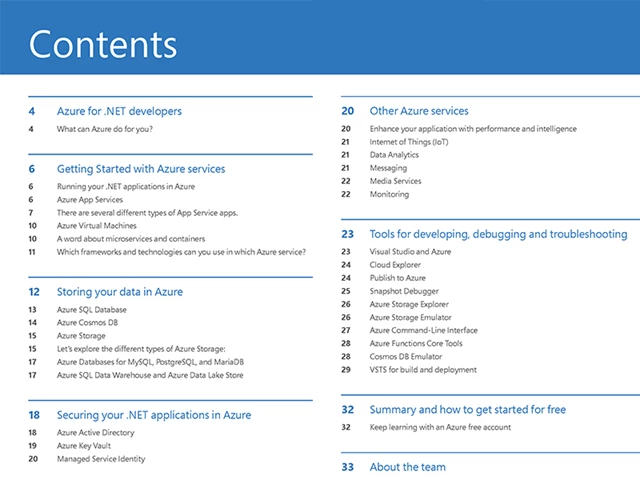Azure SQL Database, Compute, Container Services, Databases, How to
Get the Azure Quick Start Guide for .NET Developers
Posted on
2 min read
This blog post was co-authored by Barry Luijbregts, Azure MVP.
If you’re a .NET developer, we’re excited to introduce a new resource that can help you learn about Azure: The Azure Quick Start Guide for .NET Developers!

Download this free e-book here.
This guide shows .NET developers how they can start with Azure and get the most out of it. The e-book is also great for .NET developers who already use Azure and want to learn more about which Azure services are available to them, and the tools they can use to develop applications for the platform.
Specifically, the Azure Quick Start Guide for .NET Developers covers:
- What Azure can do for you as a .NET developer. The guide describes how Azure can take care of things like automatic scaling, continuous integration/continuous delivery (CI/CD), and much more so you can focus on creating the things that really matter and add value.
- A catalog that explains what Azure services to use when for:
- Running your .NET applications in Azure. There are many services that you can use to run your application in Azure. For instance, the guide discusses the differences between running your app in a service like Azure App Service Web Apps and running it in Azure Container Instances.
- Storing your data. In Azure, you have many storage options for your application data. This section clarifies which services are meant for storing relational data, and which services you can use for storing NoSQL and other data. It also explains how Azure SQL Data Warehouse and Azure Data Lake Store differ.
- Securing your .NET applications. The guide describes the most useful security services in Azure for .NET developers. For example, you can use Azure Active Directory for storing user identities and doing authentication and authorization. You can also take advantage of Azure Key Vault to store your application secrets. Managed Service Identity for Azure couples your app to Azure Active Directory and injects credentials into your application without having to store them in your config files or anywhere else.
- Which tools you can use to develop .NET applications for Azure. Most of the tools in this guide are specifically for .NET developers, who already have access to the great tools available with Visual Studio. Now you can extend them with tools and workloads that make you more productive when you work with Azure, including the Snapshot Debugger, Cloud Explorer, and Azure Functions Core Tools.
For more information, check out this recent Azure Friday episode where e-book co-author Barry Luijbregts chats with Scott Hanselman about the Azure Quick Start Guide for .NET Developers, and demos some of the tools that .NET developers can use to develop and troubleshoot applications for Azure. These include Cloud Explorer and the new Snapshot Debugger, which enables you to debug applications in production without disrupting the application.
Links to items mentioned in this episode of Azure Friday:
- Get the free e-book: Getting started with Azure for .NET developers
- Selecting Workloads in Visual Studio 2017
- Azure SDKs download page
- Azure Friday about Snapshot Debugger with Application Insights
- Create a Free Account (Azure)
We hope that this free guide helps you to start your journey into Azure or to learn more about Azure if you’re already using it. If you have any questions or feedback, please don’t hesitate to reach out to the authors of the e-book on Twitter: @CesardelaTorre, @MBCrump, @AzureBarry, and @BethMassi. And be sure to check out another great resource for developers, The Developer’s Guide to Microsoft Azure.